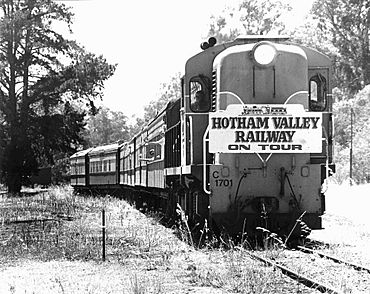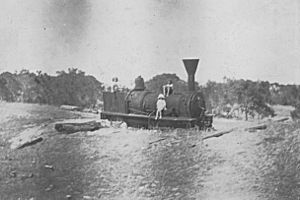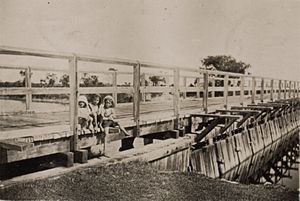Wonnerup, Western Australia facts for kids
Quick facts for kids WonnerupWestern Australia |
|
|---|---|

The last passenger train to Busselton passes through Wonnerup, January 1987.
|
|
| Population | 374 (2006 census) |
| Established | 1856 |
| Postcode(s) | 6280 |
| Elevation | 94 m (308 ft) |
| Location | |
| LGA(s) | City of Busselton |
| State electorate(s) | Vasse |
| Federal Division(s) | Forrest |
Wonnerup is a small town in Western Australia. It is located about 219 kilometers (136 miles) south of Perth. The town is also just 10 kilometers (6 miles) east of Busselton. Wonnerup officially became a town in 1856. It got its name from the nearby Wonnerup Inlet.
Contents
What Does Wonnerup Mean?
The name Wonnerup comes from the Aboriginal language. It has been shown on maps of the area since 1839. The name means "place of the woman's digging or fighting stick."
The Noongar Language
The Noongar people are the traditional owners of this land. In their language, the word wonna means "fighting stick." The ending -up means "place of." So, Wonnerup means "place of the wonna."
The wonna stick was made from the peppermint tree, called Agonis flexuosa. This tree is native to the southwest coast of Australia. The wonna was an important item that the Noongar people often traded with others.
Wonnerup's Railway History
Wonnerup played an important part in Western Australia's railway history. The first railway and railway bridge in Western Australia were built here.
The Ballaarat Tramline
The Ballaarat Tramline was built in 1871. It was located in an area called Lockville, which is part of Wonnerup. This tramline was a very early railway system.
Later, Wonnerup became a key railway junction. It connected the railway line from Bunbury to Busselton. It also connected to the Nannup Branch Railway. This made Wonnerup an important hub for trains.




